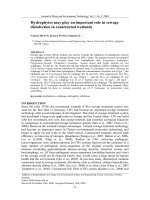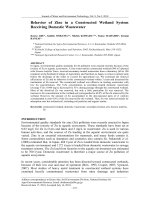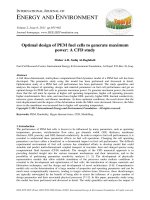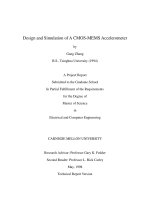Design of a constructed wetland
Bạn đang xem bản rút gọn của tài liệu. Xem và tải ngay bản đầy đủ của tài liệu tại đây (95.38 KB, 5 trang )
Design of a constructed wetland (CW)
Constructed wetlands (CWs) are planned systems designed and constructed to employ
wetland vegetation to assist in treating wastewater particularly secondary and tertiary
treatment of municipal, industrial wastewater. The system is particularly useful for treating
septic tank effluent or grey water, landfill leachate and other wastes that require removal of
high concentrations organic materials, suspended solids, nitrate, pathogens and other
pollutants. CWs should not be used to treat raw sewage and, in industrial situations, the
wastes may need to be pre-treated so that the biological elements of the wetlands can
function effectively with the effluent.
Subsurface flow (SSF) systems are most appropriate for treating primary wastewater,
because there is no direct contact between the water column and the atmosphere, there is
no opportunity for vermin to breed, and the system is safer from a public health perspective.
The environment within the SSF bed is mostly either anoxic or anaerobic. Oxygen is supplied
by the roots of the emergent plants and is used up in the Biofilm growing directly on the roots
and rhizomes, being unlikely to penetrate very far into the water column itself. SSF systems
are good for nitrate removal (denitrification), but not for ammonia oxidation (nitrification),
since oxygen availability is the limiting step in nitrification.
The environment in the Free Water Surface (FWS) systems is generally aerobic at, and near,
the surface, tending toward anoxic conditions near the bottom sediment. The microbial film
grows on all available plant surfaces, and is the main mechanism of pollutant removal. FWS
usually exhibits more biodiversity than does SSF systems.
Accurate hydrological budget is needed to properly design a CW. The water balance to a
wetland can be calculated as:
(21)
Where Q
i
is influent wastewater flow (volume/time), Q
e
is effluent wastewater flow
(volume/time), P is the precipitation (volume/time), ET is evapotranspiration (volume/time), V
is volume and t is time.
Attached growth models are the most common approach used to design constructed wetland
systems. Depending on the type of CW being designed, a completely mixed reactor (no
concentration gradients within the CW) or Plug flow (no back mixing) may be used.
The general relationship for first-order plug flow models is:
(22)
Hydraulic residence time is represented as:
or (23)
Substituting for t:
or (24)
Where k
T
is calculated using equation (7).
Where C
e
is effluent BOD
5
(mg/l), C
o
is influent BOD
5
(mg/l), k
T
= Temperature dependent first
order reaction kinetics rate constant (day
-1
), t is hydraulic residence time (day), Q is average
flow rate through the system (m
3
/d), h is depth of the submergence (m), ε is Porosity of the
bed as a fraction and A
s
is surface area of the systems, m
2
.
Basing on First Order - Reaction Kinetics – Plug Flow Approach, two research-based design
methods exist:
· Reed´s method for the design of constructed wetlands
· Kadlec and Knight design method
Reed’s method for the design of constructed wetlands
This method is is based on the first-order plug flow assumption for those pollutants that are
removed primarily by biological processes (i.e. BOD, ammonia, nitrate).
[8]
Reed suggests
separate equations for total suspended solids (TSS) and total phosphorus (TP). For the
removal of pathogenic organisms in CWs, the same approach as that used for WSPs.
For removal of BOD, NH4 and NO3 in constructed
wetlands:
Equations 22 – 24 apply.
For TSS removal:
In SSF wetlands: (25)
In FWS wetlands: (26)
For Pathogen Removal:
Reed argues that the mechanisms for pathogen removal are essentially the same in both
waste stabilization ponds and constructed wetlands. Then (27)
For TP removal:
In both SSF and FWS wetlands: (28)
The cross-sectional area of the flow is then calculated as:
(29)
And the bed width
(30)
Where
C
e
is effluent faecal coliform concentration (number/100 mL), C
o
is influent faecal coliform
concentration (number/100 mL), k
T
is temperature dependent rate constant (day
-1
), is number
of cells in series, t = Hydraulic residence time (days)
The cross sectional area and bed width are determined on the basis of Darcy’s law:
(31)
Where K
p
is first order phosphorous reaction rate (2.73 cm/day), A
c
is cross-sectional area of
wetland bed (d*W) perpendicular to the direction of flow (m
2
), d is the depth (m), K
s
is the
hydraulic conductivity of the medium (m
3
/m
2
.day), S is The slope of the bed or hydraulic
gradient (as a fraction or decimal).
Kadlec and Knight design method
A first-order decay, plug flow model for all pollutants, including BOD, TSS, total phosphorous
(TP), total nitrogen (TN), organic nitrogen (OrgN), ammonia nitrogen (NH4-N), oxidised
nitrogen (NOx-N), and faecal coliform (FC) is assumed.
[9]
Their model is based on areal rate
constants, which are independent of temperature.
(32)
Where (33)
(34)
Alternatively
(35)
Where A
s
is treatment area of the wetland (m
2
), C
e
is target effluent concentration (mg/l), C
i
is
target influent concentration (mg/l), C* is background pollutant concentration (mg/l), K
T
is first
order aerial rate constant (m/yr), q is hydraulic loading rate (m/yr), Q is average flow rate
through the wetland (m
3
/day).
Kadlec and Knight
[9]
advocate the use of the “global” parameters they determined from plug
flow analysis of performance data available to date on the North American Data Base
(NADB)
[10]
in other systems. They suggest that specific parameters should be locally
determined prior to investment in a full-scale system, in order to ensure suitability of design.
Controlling organic loading
This is essential to control organic loading since it is a carbon source for denitrifying bacteria
and to prevent overloading of the oxygen transfer ability of the emergent plants in the
wetland system. If the carbon source is not available for denitrification, then lower overall
nitrogen removal will result. Heavy organic loading, especially if not evenly distributed, will
cause plant die off and odours.
[11]
BOD organic loading is expressed as follows:
(36)
Where OLR is BOD Organic Loading Rate Rates (kg/ha.d), Q is a verage flow rate through
the system (m
3
/d), C
i
is Influent BOD
5
(mg/l), As is Surface area of the systems (m
2
). The
BOD loading for SSFCW should not exceed 133 kg/ha.day.
[12]
Controlling hydraulic loading
Hydraulic loading rate (HLR) refers to the loading on a water volume per unit area basis. It It
is as determined as:
(37)
Where HLR is hydraulic Loading Rate (cm/day), Q is average flow rate through the system
(m
3
/d), A
s
is surface area of the systems (m
2
).
Hydraulic Loading Rate should not exceed 5cm/day. However Tanzanian experience
reveals that Hydraulic loading of up to 20cm/day provide sufficient wastewater
treatment.
Determine the Bed slope and Retention time
of wastewater in the system
While bed slope influence water velocity in a treatment wetland thereby providing sufficient
hydraulic gradient through the wetland, treatment performance in CWs is a function of
detention time, among other factors. On one hand shorter detention times do not provide
adequate time for pollutant degradation to occur. Longer detention times on the other hand
can lead to stagnant, anaerobic conditions.
Bed slope is determined as follows:
(38)
Detention Time is determined as follows:









